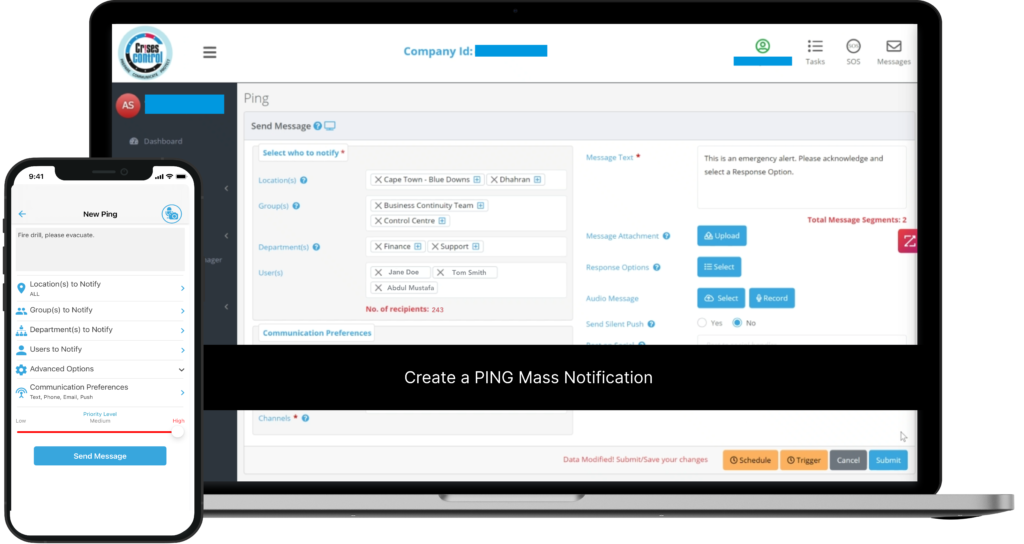Written by Anneri Fourie | Marketing Executive
In our increasingly connected world, public health emergencies can strike without warning—from pandemics and infectious disease outbreaks to localised threats like chemical spills or foodborne illnesses. For managers responsible for the safety of employees and the public, quick and clear communication during these crises is crucial. Emergency Mass Notification systems serve as your first line of defence, ensuring timely and effective communication that can save lives and maintain order.
In this blog, we’ll explore how Emergency Mass Notification systems play a vital role in managing public health crises. You’ll learn about the key features that make these systems indispensable, real-world examples of their impact, and practical tips for optimising your communication strategies. Discover how Crises Control’s advanced solutions can help you leverage these tools to enhance your organisation’s preparedness and response during emergencies.
Understanding Emergency Mass Notification Systems in Public Health Crises
Emergency Mass Notification systems are critical tools designed to rapidly disseminate urgent information across multiple channels—such as SMS, email, voice calls, and mobile apps. During public health crises, these systems ensure that the right people receive timely alerts and instructions, allowing them to take appropriate action.
Whether it’s informing employees about new health protocols, alerting the public about a disease outbreak, or coordinating emergency response teams, mass notification systems are the backbone of public health crisis management. Let’s explore why these systems are essential, look at real-world use cases, and discuss how Crises Control can help your organisation stay prepared.
The Role of Emergency Mass Notification in Public Health Emergencies
1. Rapid Communication Prevents Misinformation and Panic
During public health emergencies, misinformation can spread faster than the crisis itself, leading to confusion, fear, and sometimes harmful behaviours. A robust Emergency Mass Notification system combats this by delivering accurate, real-time updates directly to employees, stakeholders, and the public.
- Problem Solved: Delayed or unclear communication can escalate a crisis. Rapid notifications ensure everyone receives consistent and authoritative guidance.
- Solution Created: Automated notifications reach your audience instantly, providing clear instructions that help maintain order and reduce panic.
- Example in Action: During the early stages of the COVID-19 pandemic, many organisations used mass notification systems to quickly update employees on evolving health guidelines, work-from-home policies, and emergency protocols. This rapid communication helped businesses continue operations while safeguarding employee health.
2. Multi-Channel Alerts: Reaching People Wherever They Are
One of the most valuable aspects of mass notification systems is their ability to send alerts through multiple channels at once. In a public health emergency, individuals may not have access to email, but can receive critical information via SMS, voice calls, or push notifications on their mobile devices.
- Benefit: Multi-channel alerts ensure the message is received, no matter the location or device used by the recipient.
- Practical Application: Organisations can quickly send health advisories, evacuation instructions, or safety updates to employees, customers, and stakeholders, maximising the reach and effectiveness of their communication.
Key Features of Effective Emergency Mass Notification Systems
1. Geo-Targeting: Precision in Reaching the Right Audience
Geo-targeting allows organisations to send alerts to specific locations or regions, ensuring that messages are relevant and reach those directly affected by a public health emergency. This is particularly useful when dealing with localised threats, such as an outbreak confined to a specific area or a chemical spill near a workplace.
- How It Works: By targeting messages based on geographical data, you can ensure that only the relevant audience receives alerts, minimising unnecessary alarm among unaffected groups.
- Example Use: During a chemical spill near an industrial facility, geo-targeted alerts can be sent to employees and local residents advising them on evacuation routes or shelter-in-place instructions, keeping the message relevant and focused.
2. Two-Way Communication: Enhancing Situational Awareness
Effective Emergency Mass Notification systems aren’t just about broadcasting information—they also facilitate two-way communication. This feature is crucial during public health emergencies because it provides valuable feedback and enhances situational awareness for crisis managers.
- Problem Solved: Two-way communication allows organisations to quickly confirm who has received and acknowledged alerts, identify those needing assistance, and adjust their response accordingly.
- Benefit: Employees can confirm their safety, ask questions, or request help, making the overall response more dynamic and informed.
- Example in Action: During a health crisis, employees can report symptoms, confirm their ability to work, or request help directly through the system. This feedback loop provides managers with the information needed to make quick, informed decisions.
How Crises Control Supports Your Public Health Crisis Response
Crises Control is a comprehensive, user-friendly Emergency Mass Notification platform that meets the demands of public health crises. Here’s how Crises Control can help your organisation stay prepared and responsive during emergencies:
1. Robust Multi-Channel Communication
Crises Control ensures that critical messages reach your audience quickly through SMS, email, voice calls, push notifications, and more. This multi-channel approach significantly reduces the chances of missed alerts during critical moments.
2. Advanced Geo-Targeting Capabilities
Crises Control’s geo-targeting feature allows you to send precise alerts to specific locations, ensuring relevant information reaches those who need it most. Whether you’re notifying employees at a specific site or alerting residents in a neighbourhood, Crises Control delivers messages with pinpoint accuracy.
3. Two-Way Messaging for Enhanced Response
Crises Control’s two-way communication capabilities allow recipients to acknowledge alerts or respond with their status, giving managers real-time insights into the effectiveness of their communication. This feedback loop is invaluable during public health emergencies, enabling better response coordination.
4. Integration with Crisis Management Tools
Crises Control goes beyond mass notifications by integrating with incident management, task management, and other crisis response tools. This all-in-one approach streamlines your emergency response efforts, helping your organisation remain agile and effective in any public health threat.
To further understand how Crises Control supports businesses during health crises, check out our detailed white paper, “Helping Businesses to Survive Through COVID-19.” This resource provides valuable insights and strategies for leveraging mass notification systems to navigate challenges similar to those experienced during the pandemic.
Interested in our Ping Mass Notification Software?
Efficiently alert everyone in seconds at scale with our Mass Notification System – PING, get the message out fast and ensure rapid response and recovery.

Conclusion: Be Prepared for the Next Public Health Crisis with Crises Control
Public health emergencies demand a rapid, organised response, and Emergency Mass Notification systems are a critical part of this strategy. Crises Control provides a reliable, feature-rich platform designed to keep your employees, stakeholders, and the public informed and safe during health crises.
Don’t wait for the next emergency to strike—equip your organisation with Crises Control’s advanced notification capabilities today. Contact us for a free personalised demo and discover how our system can become the backbone of your public health crisis response.
Request a FREE Demo

